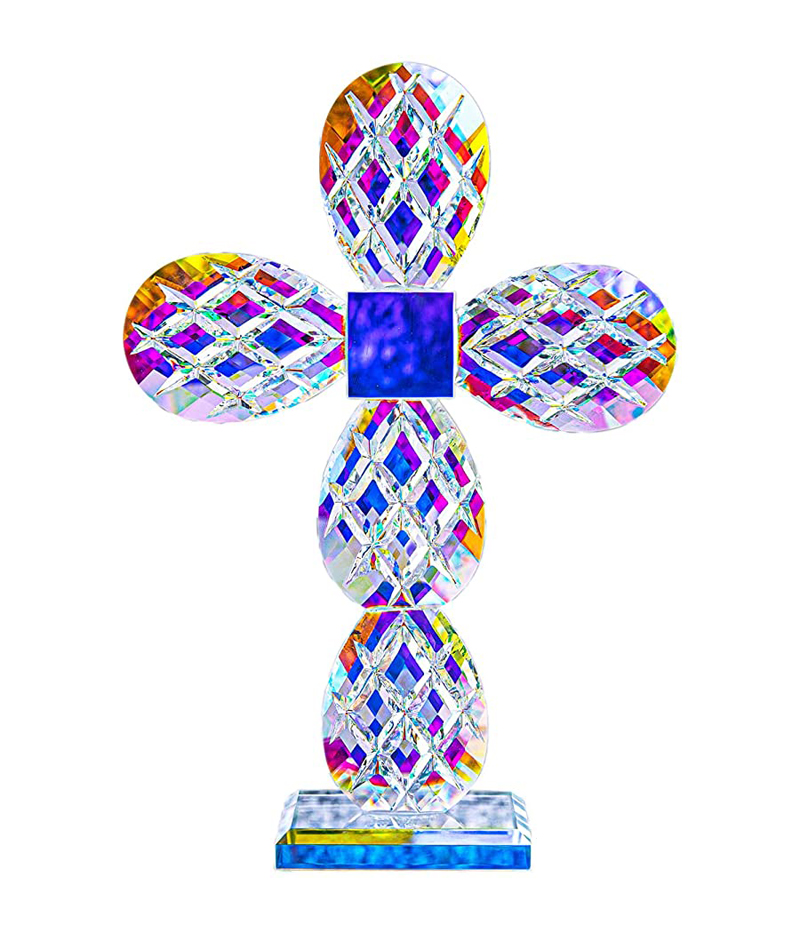Standing Colorful Crystal Cross “for Mothers Day” Statue
This expertly crafted and carefully designed Colorful Crystal Cross Statue is completely handmade, made of high quality K9 crystal. Shining more than a glass cross, it will be a beautiful addition to your spirit. The Cross, once the cruelest form of execution, yet now it is a symbol of abundant life. Crystal cross signify magic, mystery, royalty, and good judgment. It define a feeling of calm or a feeling of energy. The energies of cross have the ability to get rid us of obstacles and restore the balance into our life. Stand the elegant crystal cross on your window sill and let the light shine through to radiate God’s love throughout your home “Rainbow“. A cross is a geometrical figure consisting of 2 intersecting lines or bars, usually perpendicular to each other. The lines usually run vertically and horizontally. A cross of oblique lines, in the shape of the Latin letter X, is termed a Saltire in heraldic terminology. The Cross is a great contradiction. A simple upright post with a transverse bar used crucifixion. It’s a symbol of death, but so much more.
Death and life, hate and love, violence and peace, accusation and forgiveness, sin and purity, brokeness and wholeness, all is lost yet everything is gained, destruction and restoration, defeat and victory. Once the cruelest form of execution, yet now it is a symbol of abundant life. The cross in its various shapes and forms was a symbol of various beliefs. In pre-Christian times it was a pagan religious symbol throughout Europe and western Asia. In ancient times, the effigy of a man hanging on a cross was set up in the fields to protect the crops. The cross was even considered a male symbol of the phallic Tree of Life, thus it often appeared in conjunction with the female-genital circle or oval, to signify the sacred marriage, as in Egyptian amulet Nefer with male cross and female orb, considered as an amulet of blessedness, a charm of sexual harmony. The word cross is recorded in 11th-century Old English as cros, exclusively for the instrument of Christ’s crucifixion, replacing the native Old English word rood. The word’s history is complicated, it appears to have entered English from Old Irish, possibly via Old Norse, ultimately from the Latin crux (or its accusative crucem and its genitive crucis), “stake, cross“.
The English verb to cross arises from the noun, first used in the sense “to make the sign of the cross“, the generic meaning “to intersect” develops in the 15th century. The Latin word was, however, influenced by popular etymology by a native Germanic word reconstructed as krukjo (English crook, Old English crycce, Old Norse krokr, Old High German krucka). This word, by conflation with Latin crux, gave rise to Old French crocier (modern French crosse), the term for a shepherd’s crook, adopted in English as crosier. Latin crux referred to the gibbet where criminals were executed, a stake or pole, with or without transom, on which the condemned were impaled or hanged, but more particularly a cross or the pole of a carriage. The derived verb cruciare means “to put to death on the cross” or, more frequently, “to put to the rack, to torture, torment“, especially in reference to mental troubles. In the Roman world, furca replaced crux as the name of some cross-like instruments for lethal and temporary punishment, ranging from a forked cross to a gibbet or gallows.
The field of etymology is of no help in any effort to trace a supposed original meaning of crux. A crux can be of various shapes, from a single beam used for impaling or suspending (crux simplex) to the various composite kinds of cross (crux compacta) made from more beams than one. The latter shapes include not only the traditional †-shaped cross (the crux immissa), but also the T-shaped cross (the crux commissa or tau cross), which the descriptions in antiquity of the execution cross indicate as the normal form in use at that time, and the X-shaped cross (the crux decussata or saltire). The Greek equivalent of Latin crux “stake, gibbet” is stauros, found in texts of 4 centuries or more before the gospels and always in the plural number to indicate a stake or pole. From the first century BC, it is used to indicate an instrument used in executions. The Greek word is used in descriptions in antiquity of the execution cross, which indicate that its normal shape was similar to the Greek letter tau (T). Standing Colorful Crystal Cross “for Mothers Day” Statue measures: 6.4 inches / 16 cm x 9 inches / 23 cm x 3 inches / 7.5 cm.
Colorful Crystal Cross Statue on Amazon.
Colorful Crystal Cross Statue on eBay.
Religious Statues, Christianity Statues and Symbolic Statues.



